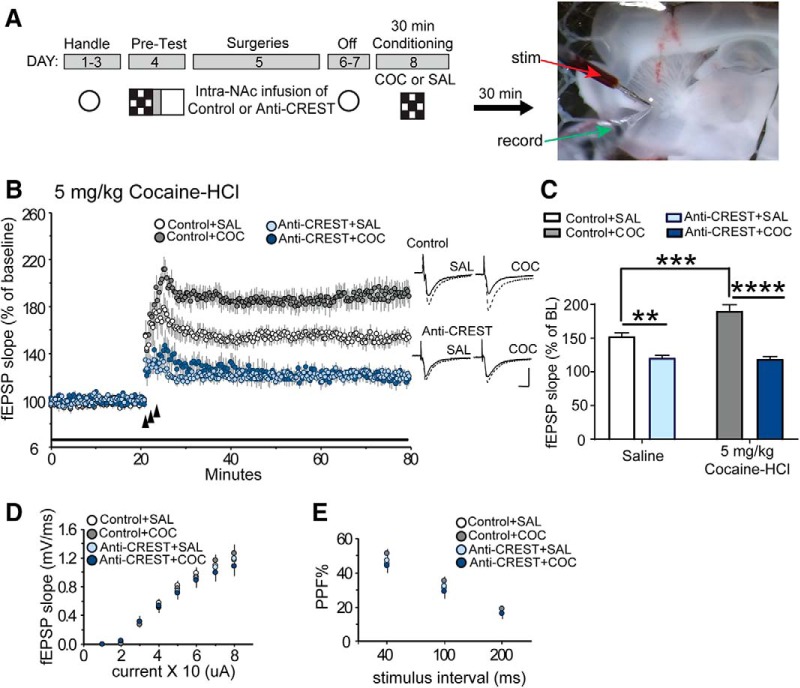Figure 4.
Anti-CREST morpholino blocks theta-burst-induced LTP in the NAc core. A, Left, Schematic describing the cocaine-CPP and image of an acute slice containing the NAc. Animals underwent handling, a pre-test, intra-NAc infusion surgeries, and then 2 d off. The next day, mice received either saline or 5 mg/kg cocaine-HCl immediately before a single 30 min exposure to one compartment. There was a 30 min lag period between the end of animal testing and sacrificing the animal for electrophysiology studies (horizontal black arrow). Right, Image illustrates the placement of the recording (green arrow) and stimulating (stim) electrode (red) in a NAc core slice. B, Theta burst-induced LTP (3 small upward arrows) produced reliable stable potentiation in slices from control mice that received an infusion of control + injection of saline (Control+SAL; white circles, n = 12). LTP was significantly enhanced in slices from Scrambled morpholino control (depicted as Control in figure) mice that received an intraperitoneal injection of 5 mg/kg cocaine-HCl (Control+COC; gray circles, n = 10) compared with saline-injected mice. Infusions of anti-CREST morpholino (depicted as Anti-CREST in figure) into the NAc significantly impaired theta burst-induced LTP in this area in mice that received saline injections (light blue circles; n = 8) relative to control mice; however, a 5 mg/kg dose of cocaine-HCl could not overcome anti-CREST-induced impairment in LTP (anti-CREST+COC; dark blue circles; n = 7). There was a marked reduction in the level of potentiation 60 min post-TBS in these slices relative to control mice. Right, Representative traces collected during baseline (solid line) and 50 min post-TBS (dotted line) for each group. C, Summary graph representing average change in fEPSP slope as percentage of baseline (BL) for each group. Control animals that received 5 mg/kg cocaine-HCl showed facilitated potentiation compared with Control animals that received saline. The level of potentiation during 50–60 min post-TBS period showed a significant reduction in anti-CREST + saline compared with Control + saline. anti-CREST + cocaine-HCl (5 mg/kg) also showed significantly reduced potentiation compared with Control + cocaine-HCl (5 mg/kg). D, Input (stimulation current)/output (slope of fEPSP) relationships were not detectably different between groups. E, Transmitter release kinetics, as assessed with paired pulse facilitation (PPF), were also comparable for the four groups of slices. Scale: 0.4 mV/5 ms. **p < 0.01, ***p < 0.001, ****p < 0.0001.

